Souvenirs of the
M.S. Wilhelm Gustloff
M.S. Wilhelm Gustloff
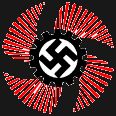
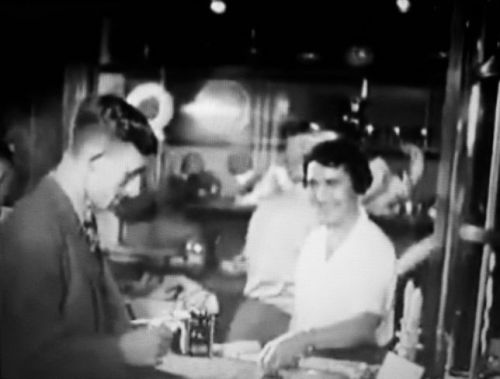
Like any other ship sailing the seas, the Wilhelm Gustloff had an on board gift shop near her dining room where passengers could purchase items to remember the voyage. The photo at right is of her gift shop with a passenger purchasing a camera. No doubt, the souvenirs of the Gustloff are the most interesting pieces due to the wide variations of items that were available.
Many other items featuring the Wilhelm Gustloff were made for the German market and not sold aboard the liner. In more recent times, reproduction and fake items from the Gustloff have surfaced and made their way into auctions.
Many other items featuring the Wilhelm Gustloff were made for the German market and not sold aboard the liner. In more recent times, reproduction and fake items from the Gustloff have surfaced and made their way into auctions.
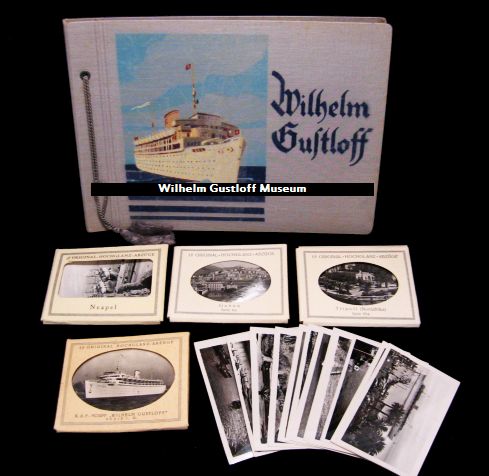
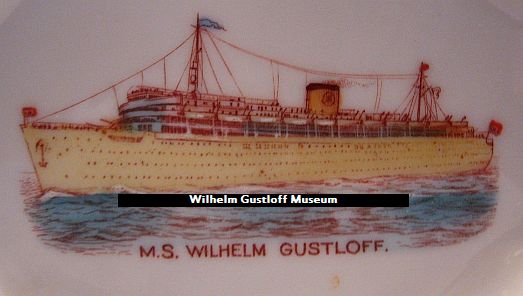
Wilhelm Gustloff Mützenbands - a.k.a. Hatbands, Cap Tallies
Displayed here are mützenbands, or sailor's cap bands, which would have been wrapped around the bottom portion of a hat and tied off in the back. These are the most notable items sold on board the Wilhelm Gustloff due to their size and beauty. There are six versions in existence, versions 2-5 were originally sold on board the liner as souvenirs. They are as follows:
1: Wilhelm Gustloff in gold with solid black background; specifically for the hats of crew members. (As shown in photos such as the LIFE magazine article and in many photos of her crew on deck.) This is the only crew tally I have ever seen - it belonged to Otto Ullrich who was a sailor on the Gustloff for almost her entire career. Additional information under the Building and Launch page.
2: Wilhelm Gustloff in gold with the Nazi Germany flag & DAF flag against a black background. From our 'Red Album'.
3: Wilhelm Gustloff in gold with the Nazi Germany flag & DAF flag against a black background. Has an outer red line and inner white line. The example shown above is in mint condition. We also have another of the same style. Measures 90cm long.
4: Wilhelm Gustloff in blue with the Nazi Germany flag and DAF flag against a white background. Has a red stripe on the outer sides and a black stripe on the inner sides. Ours is in near-mint condition and measures 88cm. We also have another of this style in the same condition. These are from her maiden voyage as two are known to have been purchased on said trip. This would explain the few sightings of them.
5: Wilhelm Gustloff in blue with the Nazi Germany flag and DAF flag against a white background. No red or black stripes at the top and bottom.
Displayed here are mützenbands, or sailor's cap bands, which would have been wrapped around the bottom portion of a hat and tied off in the back. These are the most notable items sold on board the Wilhelm Gustloff due to their size and beauty. There are six versions in existence, versions 2-5 were originally sold on board the liner as souvenirs. They are as follows:
1: Wilhelm Gustloff in gold with solid black background; specifically for the hats of crew members. (As shown in photos such as the LIFE magazine article and in many photos of her crew on deck.) This is the only crew tally I have ever seen - it belonged to Otto Ullrich who was a sailor on the Gustloff for almost her entire career. Additional information under the Building and Launch page.
2: Wilhelm Gustloff in gold with the Nazi Germany flag & DAF flag against a black background. From our 'Red Album'.
3: Wilhelm Gustloff in gold with the Nazi Germany flag & DAF flag against a black background. Has an outer red line and inner white line. The example shown above is in mint condition. We also have another of the same style. Measures 90cm long.
4: Wilhelm Gustloff in blue with the Nazi Germany flag and DAF flag against a white background. Has a red stripe on the outer sides and a black stripe on the inner sides. Ours is in near-mint condition and measures 88cm. We also have another of this style in the same condition. These are from her maiden voyage as two are known to have been purchased on said trip. This would explain the few sightings of them.
5: Wilhelm Gustloff in blue with the Nazi Germany flag and DAF flag against a white background. No red or black stripes at the top and bottom.
Wilhelm Gustloff Souvenir China
I was reading an article at TimesOnline titled: 'Pirate divers face jail for looting Nazi ghost liner', By: Roger Boyes, December 9, 2004. I found the following two lines interesting because these ashtrays are the only type known manufactured with the ship's picture and name. The quote, which talks about the recent problems looters have caused, is this (pertaining to one removed from the wreck):
"Enforcing the clampdown may prove difficult, given the significant financial rewards for divers. German collectors will offer 10,000 Euros ($13,500) or more for an ashtray marked with the name of the ship."
Glass ashtrays were used on the ship, but never marked with the Gustloff name or identifying markings. Many of the souvenir china pieces would've been removed from her gift shop during the war and even if there were any on the wreck, they wouldn't bring anything near that amount.
The first photo shows the largest piece of souvenir porcelain - a teapot from the Wilhelm Gustloff. 7" long by 4" wide and 4" high. Marked "Bauscher Weiden". This mark was used from c.1920 to c.1939. The large saucer is 6.5" in diameter. What is interesting about this piece is that it was made by KPM and dated 1/1940.
The perfume bottles are another souvenir piece from the Gustloff. In mint condition, they sport two different images of the Gustloff and have the 4-digit code '6055' on the bottom. On the backside, there is a worn gold shield with the letter 'G' for the one at left. The bottles are light pink in color, though it is hard to tell in the photo. The crown on the top twists open to allow the perfume to come through the 4 small holes on the top. The one of the Robert Ley in our collection came with the original box and price tag from the ship's gift ship.
Next are several variations of ash trays. Measuring approximately 11 x 8 cm, these ashtrays (like many of the other pieces) were created as part of a "special edition of souvenir articles" by world-renowned porcelain manufacturer Fürstenberg during 1937/39. Although it does not display the distinctive blue 'F' maker mark on the bottom, it is clearly part of a series based on a 1920's company design called "Germania". This is noted by a 'G' sticker that still remains on some of the pieces. Some pieces simply contain a four-digit number.
After years of collecting, I've learned that there are several companies that have produced souvenir items for the Wilhelm Gustloff including Bauscher Weiden, Königliche Porzellan Manufaktur, and Gerold Porzellan of Bavaria. However, some of these transfer decal pieces were not sold on board, rather to the general public separate from the liner itself.
Wilhelm Gustloff Pins / Nadel / Anstecknadel / Abzeichen
Pins were the smallest items sold on board the liner as souvenirs. Shown here is my current collection of pins in its entirety. The first is a standard Nazi party stickpin which would have been one of the non-labeled pins sold aboard.
Across the top row after that are the 4 variations of the white enamel M.S. Wilhelm Gustloffship wheel pins: Standard Nazi flag, KdF flag in silver, DAF flag in red metallic, and DAF in standard red with an extended pin stick.
A different variation is an interesting bow pin of the Gustloff (middle row) with a white liner with gold and black surroundings. The middle row also holds my E.S. Robert Ley pins in DAF flag, Bow version, and KdF flag form. I am still on the lookout for the standard version of this pin.
The Hamburg / HAPAG flag is a non-Gustloff pin that probably would have also been sold on board the Robert Ley or in Hamburg at the piers. This one is backmarked GES. GESCH.
The HSDG flag would have been attached to a patch for an officer or captain of the Hamburg South America Line.
Pins were the smallest items sold on board the liner as souvenirs. Shown here is my current collection of pins in its entirety. The first is a standard Nazi party stickpin which would have been one of the non-labeled pins sold aboard.
Across the top row after that are the 4 variations of the white enamel M.S. Wilhelm Gustloffship wheel pins: Standard Nazi flag, KdF flag in silver, DAF flag in red metallic, and DAF in standard red with an extended pin stick.
A different variation is an interesting bow pin of the Gustloff (middle row) with a white liner with gold and black surroundings. The middle row also holds my E.S. Robert Ley pins in DAF flag, Bow version, and KdF flag form. I am still on the lookout for the standard version of this pin.
The Hamburg / HAPAG flag is a non-Gustloff pin that probably would have also been sold on board the Robert Ley or in Hamburg at the piers. This one is backmarked GES. GESCH.
The HSDG flag would have been attached to a patch for an officer or captain of the Hamburg South America Line.

Two reproduction / fake containers of the Wilhelm Gustloff.
These are two unusual heavy paper containers from the Wilhelm Gustloff of which I have never seen before until now. However, these are cheap reproductions that made a sudden appearance on the market. Indications they are fake are the poorly cut circles which are on the top (I would expect a higher standard for KdF cruises.) Neither container has the image of the Gustloff on the front and each was made on a bad printer. The left container reads "See-Urlaubsreise. 21.Reise. Wilhelm Gustloff, Kraft Durch Freude" and it is in very aged condition with separation issues. The right container is in much better condition and reads "Wilhelm Gustloff", 24. Reise, 1938/39, Kraft Durch Freude. Each opens for storage of some sort. Each is 6cm in diameter and 2.5cm in height. I've seen people asking €499 online for these - but their actual value is around €2.00.
These are two unusual heavy paper containers from the Wilhelm Gustloff of which I have never seen before until now. However, these are cheap reproductions that made a sudden appearance on the market. Indications they are fake are the poorly cut circles which are on the top (I would expect a higher standard for KdF cruises.) Neither container has the image of the Gustloff on the front and each was made on a bad printer. The left container reads "See-Urlaubsreise. 21.Reise. Wilhelm Gustloff, Kraft Durch Freude" and it is in very aged condition with separation issues. The right container is in much better condition and reads "Wilhelm Gustloff", 24. Reise, 1938/39, Kraft Durch Freude. Each opens for storage of some sort. Each is 6cm in diameter and 2.5cm in height. I've seen people asking €499 online for these - but their actual value is around €2.00.
Souvenir Photo Album & Photo Packs
This is one example of a souvenir album sold aboard. There were 3 sizes for these albums - 12cm x 10cm, 25cm x 18cm, and 28.5cm x 22cm.
Souvenir photos of the Gustloff were sold in packs of 12 along with 12 packs of the various destinations. Right top clockwise: Naples, Genoa, Tripoli, and Madeira without the protective sleeve, and the Wilhelm Gustloff.
Below:An earlier version of a souvenir photo album.
This is one example of a souvenir album sold aboard. There were 3 sizes for these albums - 12cm x 10cm, 25cm x 18cm, and 28.5cm x 22cm.
Souvenir photos of the Gustloff were sold in packs of 12 along with 12 packs of the various destinations. Right top clockwise: Naples, Genoa, Tripoli, and Madeira without the protective sleeve, and the Wilhelm Gustloff.
Below:An earlier version of a souvenir photo album.


Norwegian Fjords Cruise with the Kraft Durch Freude Pin
Dated 1939
Featuring the Wilhelm Gustloff directly on the pin. Single clip pin in the back with the makers markings. This is the stock photo from before I purchased it (hence the covered swastika.) No matter how many times I tried to rephotograph it, I could not get a clear image.
Dated 1939
Featuring the Wilhelm Gustloff directly on the pin. Single clip pin in the back with the makers markings. This is the stock photo from before I purchased it (hence the covered swastika.) No matter how many times I tried to rephotograph it, I could not get a clear image.

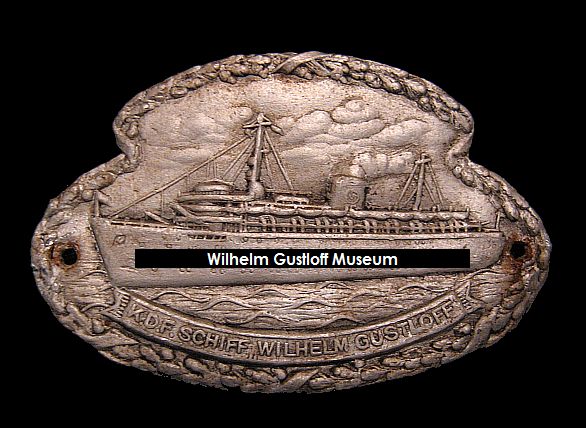
K.D.F. Schiff Wilhelm Gustloff Pin
This badge was issued in 1939 to commemorate the ship taking part in returning the men of the Condor Legion from Spain to Germany during May of that year. 1.75" x 1.2" high, appears to be made of tin. Originally made as a pin, you can see the pin on the back was removed and someone poked two holes on both sides to nail on something as a plaque.
This badge was issued in 1939 to commemorate the ship taking part in returning the men of the Condor Legion from Spain to Germany during May of that year. 1.75" x 1.2" high, appears to be made of tin. Originally made as a pin, you can see the pin on the back was removed and someone poked two holes on both sides to nail on something as a plaque.
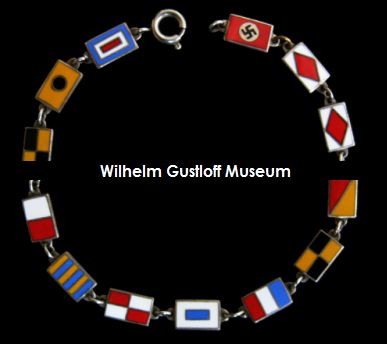

Wilhelm Gustloff Souvenir Bracelet - Nautical Flags & Nazi Flag
One of the more beautiful souvenir pieces made for the KdF fleet were bracelets in nautical flags spelling out the name of the ship it was from. Presented here is the Wilhelm Gustloff's souvenir bracelet made up of 13 flags and it measures just under 7.5 inches long.
One of the more beautiful souvenir pieces made for the KdF fleet were bracelets in nautical flags spelling out the name of the ship it was from. Presented here is the Wilhelm Gustloff's souvenir bracelet made up of 13 flags and it measures just under 7.5 inches long.
W - I - L - H - G - U - S - T - L - O - F - F
One of these Wilhelm Gustloff bracelets in another collection was obtained by a British citizen who stayed aboard the ship during a athletic youth rally prior to the outbreak of war. This was voyage #39 from June 10th to 16th, 1939.
My collection also has the same bracelet from the Robert Ley, which is presented on the ES Robert Ley page. The Gustloff bracelet comes with the Nazi flag on the end, and the Robert Ley has the Nazi flag at the beginning and the Kraft Durch Freude or HAPAG flag at the end. Our Robert Ley bracelet was purchased by passenger Erika Kepler on her 3rd trip - the "Anniversary Voyage for the People of the Eickhoff Firm, Mechanical Engineering and Iron Foundry, Bochum" - June 7th to the 11th, 1939. It came with a large lot from the trip.
Another bracelet was ordered, but lost in the mail when the envelope it was in tore open and the bracelet fell out. I currently have 3 of these in the collection.
One of these Wilhelm Gustloff bracelets in another collection was obtained by a British citizen who stayed aboard the ship during a athletic youth rally prior to the outbreak of war. This was voyage #39 from June 10th to 16th, 1939.
My collection also has the same bracelet from the Robert Ley, which is presented on the ES Robert Ley page. The Gustloff bracelet comes with the Nazi flag on the end, and the Robert Ley has the Nazi flag at the beginning and the Kraft Durch Freude or HAPAG flag at the end. Our Robert Ley bracelet was purchased by passenger Erika Kepler on her 3rd trip - the "Anniversary Voyage for the People of the Eickhoff Firm, Mechanical Engineering and Iron Foundry, Bochum" - June 7th to the 11th, 1939. It came with a large lot from the trip.
Another bracelet was ordered, but lost in the mail when the envelope it was in tore open and the bracelet fell out. I currently have 3 of these in the collection.
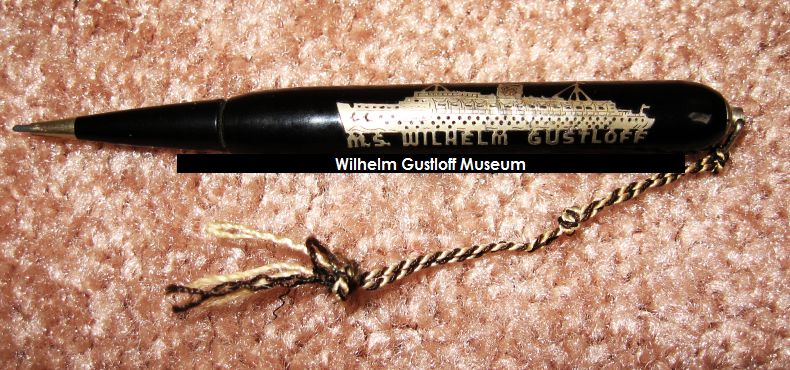
Souvenir Pocket Knife from the Gustloff.
Amber color with Gustloff ship inlay. Comes with the original leather case. 8.5cm long. Marked "Rostfrei, E.Bruckmann. Ohligs Solingen.
Souvenir Pencil from the Wilhelm Gustloff.
4" long - still maintains a small piece of lead attached to the pen unlike the Robert Ley's twin souvenir pen. Still has original braided string at the end as well.
Amber color with Gustloff ship inlay. Comes with the original leather case. 8.5cm long. Marked "Rostfrei, E.Bruckmann. Ohligs Solingen.
Souvenir Pencil from the Wilhelm Gustloff.
4" long - still maintains a small piece of lead attached to the pen unlike the Robert Ley's twin souvenir pen. Still has original braided string at the end as well.
Right:
1-2. Souvenir Donald Duck sailor's cap (modern production) with Wilhelm Gustloff cap tally.
3. A crew member's professional photo wearing his Gustloff uniform. I had ordered this photo, but it got lost / stolen in the mail from Germany to the US.
4-6. Examples of Wilhelm Gustloff crew / passengers wearing mützenbands.
1-2. Souvenir Donald Duck sailor's cap (modern production) with Wilhelm Gustloff cap tally.
3. A crew member's professional photo wearing his Gustloff uniform. I had ordered this photo, but it got lost / stolen in the mail from Germany to the US.
4-6. Examples of Wilhelm Gustloff crew / passengers wearing mützenbands.
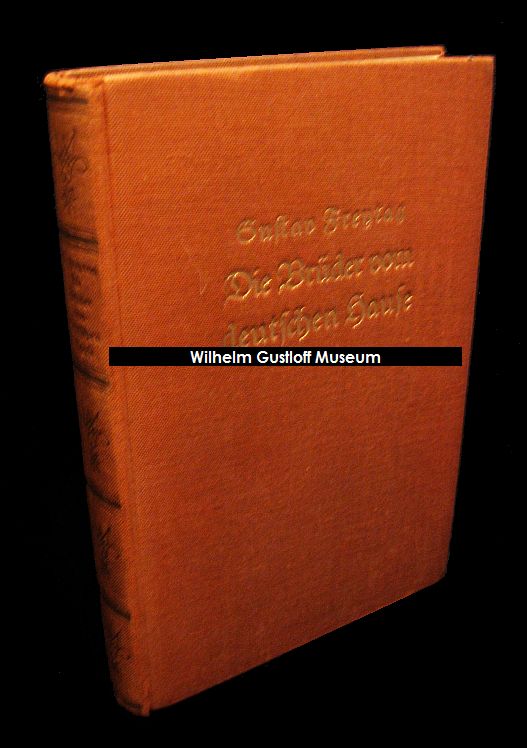
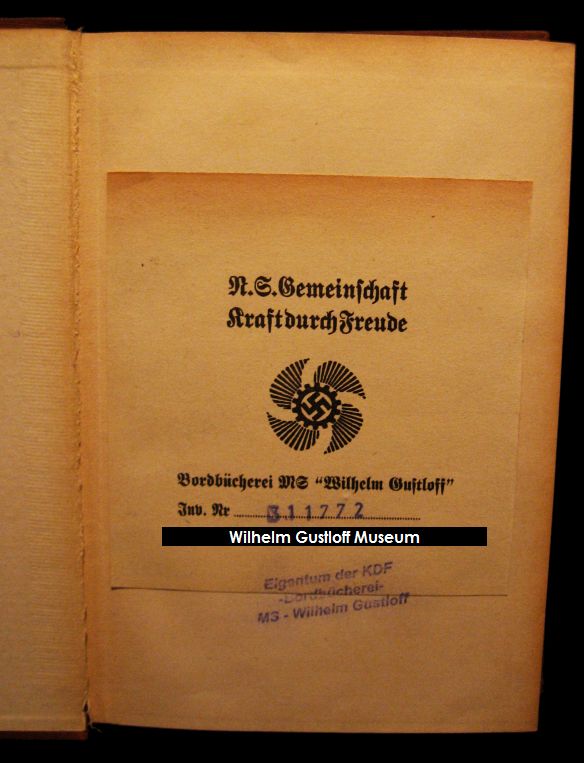
Gustav
Freytag: Die Brüder vom Deutschen Hause / The Brothers of the German
House
Marked:
Eigentum der KdF Bordbücherei
M.S. Wilhelm Gustloff FAKE /
Inventory Number 311772 Gefälschte
Unfortunately, all of these books with the label and stamp for the ship are fakes made to look like they came from on board the Wilhelm Gustloff's library.
It was first discovered with several cameras that were marked from the Robert Ley with similar stamps. While this general style of camera was in use at the time, these cameras were dated to the 1920s, and I wondered why 20 year old cameras would be used on board the new flagship of the KdF fleet? Finally, a camera appeared that was confirmed to have been made in the late 1940s with the three stamps shown:
This camera was obviously a fake since it was made several years after her final peacetime voyages, and likely after she was bombed out. I had already purchased one of these cameras and some of these books by this point, so I just decided to keep them as such.
Now it was now confirmed that the three stamps above were fakes. One of these stamps (Property of Kdf....) also appears on all of the books that have been recently appearing online. This can only mean it is a fake along with the paper label on these books. These fake books are random books taken from the 1920s and 30s and labeled / stamped with what you see above. The book shown above with the large Wilhelm Gustloff stamp is from 1883! This would be considered sub-par for the items that would be used on a brand new passenger liner. They are aged, so these were made quite some time ago.
The easiest way to see they are fakes is to look at images from both ship's libraries. Only authentic books from them will be like the one shown at right. Each new book for the Wilhelm Gustloff and Robert Ley was bound in a KdF format with the number ranging from 1 to around 1,500 and title on each of the bindings. The museum owns one original from the Robert Ley and there is another known to be in existence yet. There are currently no known examples surviving from the Wilhelm Gustloff's library.
Anything with these labels are fake items. I have seen them placed on spoons (above thumbnails), gas masks, boxes, cameras, books, picture frames, and just about any other common household item you could think of. The below thumbnail is a great image of the Wilhelm Gustloff's library I found, where if you look closely on the high resolution image, you can see all books have the same bindings.
Marked:
Eigentum der KdF Bordbücherei
M.S. Wilhelm Gustloff FAKE /
Inventory Number 311772 Gefälschte
Unfortunately, all of these books with the label and stamp for the ship are fakes made to look like they came from on board the Wilhelm Gustloff's library.
It was first discovered with several cameras that were marked from the Robert Ley with similar stamps. While this general style of camera was in use at the time, these cameras were dated to the 1920s, and I wondered why 20 year old cameras would be used on board the new flagship of the KdF fleet? Finally, a camera appeared that was confirmed to have been made in the late 1940s with the three stamps shown:
This camera was obviously a fake since it was made several years after her final peacetime voyages, and likely after she was bombed out. I had already purchased one of these cameras and some of these books by this point, so I just decided to keep them as such.
Now it was now confirmed that the three stamps above were fakes. One of these stamps (Property of Kdf....) also appears on all of the books that have been recently appearing online. This can only mean it is a fake along with the paper label on these books. These fake books are random books taken from the 1920s and 30s and labeled / stamped with what you see above. The book shown above with the large Wilhelm Gustloff stamp is from 1883! This would be considered sub-par for the items that would be used on a brand new passenger liner. They are aged, so these were made quite some time ago.
The easiest way to see they are fakes is to look at images from both ship's libraries. Only authentic books from them will be like the one shown at right. Each new book for the Wilhelm Gustloff and Robert Ley was bound in a KdF format with the number ranging from 1 to around 1,500 and title on each of the bindings. The museum owns one original from the Robert Ley and there is another known to be in existence yet. There are currently no known examples surviving from the Wilhelm Gustloff's library.
Anything with these labels are fake items. I have seen them placed on spoons (above thumbnails), gas masks, boxes, cameras, books, picture frames, and just about any other common household item you could think of. The below thumbnail is a great image of the Wilhelm Gustloff's library I found, where if you look closely on the high resolution image, you can see all books have the same bindings.
Souvenir Wallet from the Wilhelm Gustloff
With a Christmas gift tag from 1941.
With a Christmas gift tag from 1941.
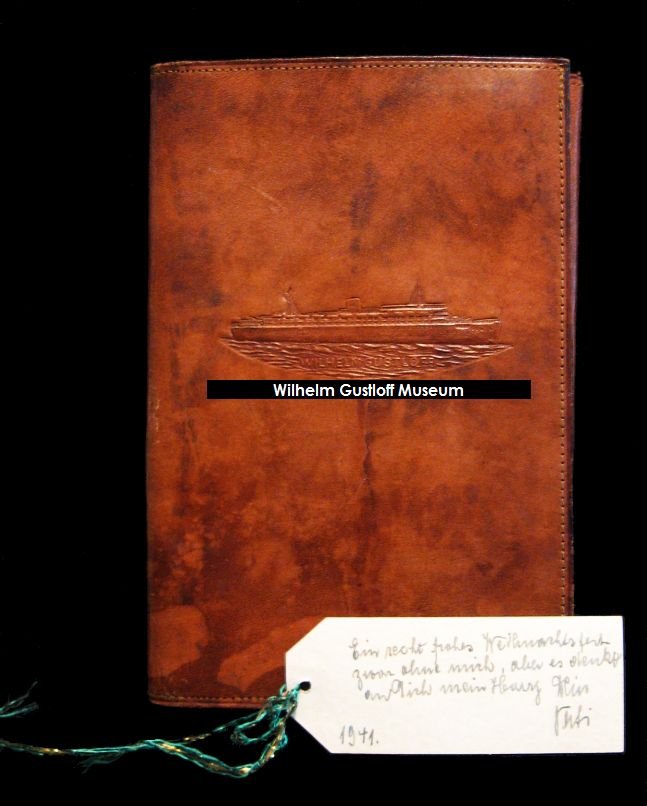
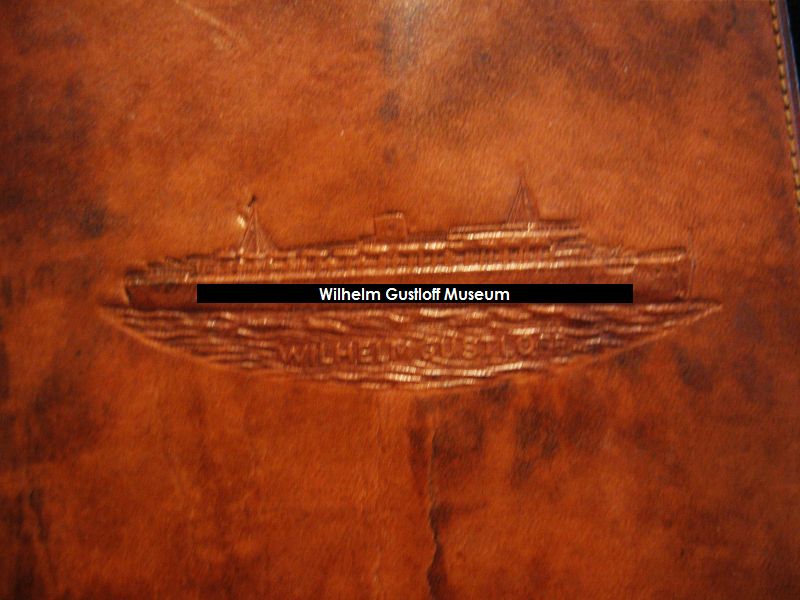
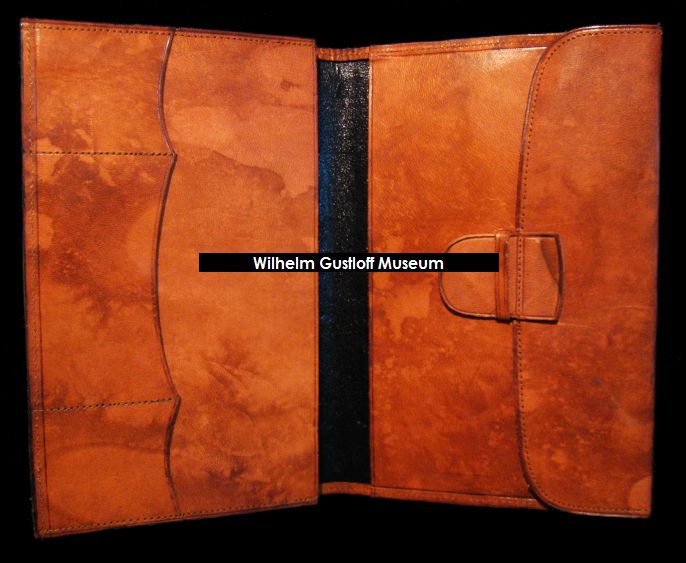
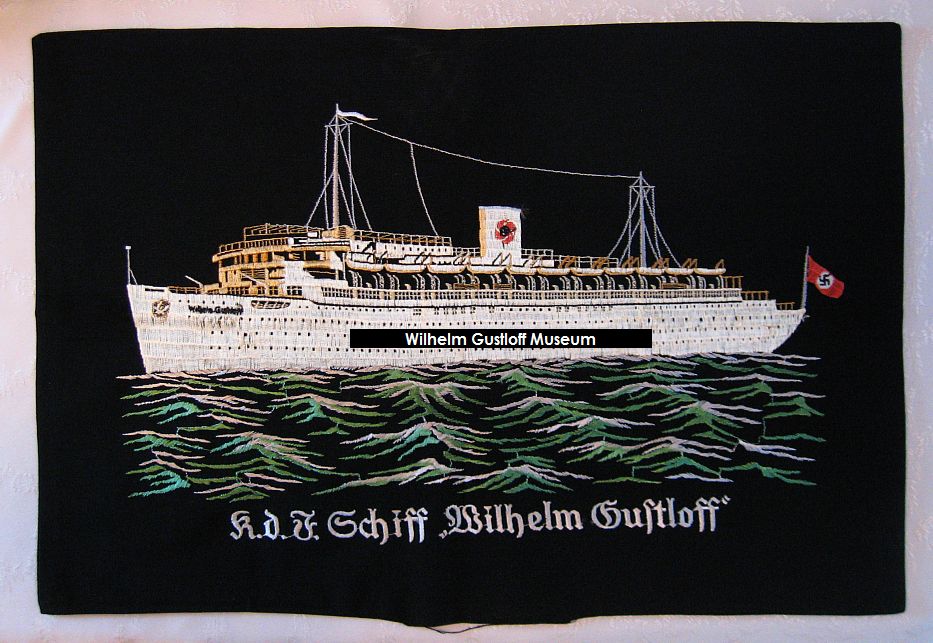
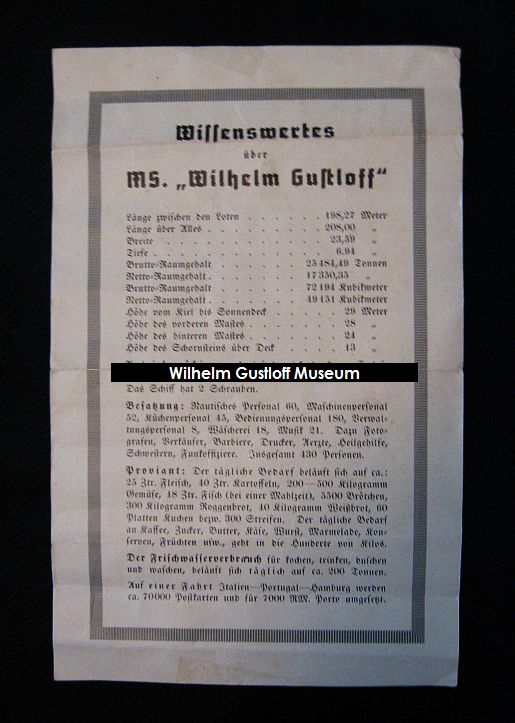
Wilhelm Gustloff Souvenir Pillow Case
Measuring 21.5" x 14.5", this piece is stunningly embroidered with a full image of the ship with K.d.F Schiff Wilhelm Gustloff at the bottom.
Attached to the case is a 'Wissenswertes über Wilhelm Gustloff' or 'Find out more about the Wilhelm Gustloff' with statistics on the ship including the basics and headlines for Antriebsmaschinen, Besatzung, Proviant, Der Frischwasserverbrauch - or Engines, crew, food, Fresh water consumption.
There is a small opening in the bottom to stuff the case and I also listed a photo of the interior at right.
I have also seen these for the Robert Ley (which I have in the collection) and the Cruiser Lützow.
Measuring 21.5" x 14.5", this piece is stunningly embroidered with a full image of the ship with K.d.F Schiff Wilhelm Gustloff at the bottom.
Attached to the case is a 'Wissenswertes über Wilhelm Gustloff' or 'Find out more about the Wilhelm Gustloff' with statistics on the ship including the basics and headlines for Antriebsmaschinen, Besatzung, Proviant, Der Frischwasserverbrauch - or Engines, crew, food, Fresh water consumption.
There is a small opening in the bottom to stuff the case and I also listed a photo of the interior at right.
I have also seen these for the Robert Ley (which I have in the collection) and the Cruiser Lützow.
Left: Souvenir Photo Album from the Gustloff's 2nd voyage.
It was her first Norwegian cruise.
Above: These are the 8 photos from the album:
(The backs are yet to be translated - but from what I can read:)
1 - May 11th, 1938
2 - Gustloff in Hamburg harbor - May 5th, 1938
3 - ----ship in the Hardangerfjord. May 10th, 1938
4 - Kriegschiff in Nordangerfjord. May 10th, 1938
5 - ----ship (Probably one of the school ships) in Nordangerfjord. May 10, 1938
6 - Passing the KdF ship St. Louis in Norway.
7 - Shuffle board with Reuben, Gretchen, and Bart. May 12th, 1938
8 - Disembarking in Hamburg - May 14th, 1938.
It was her first Norwegian cruise.
Above: These are the 8 photos from the album:
(The backs are yet to be translated - but from what I can read:)
1 - May 11th, 1938
2 - Gustloff in Hamburg harbor - May 5th, 1938
3 - ----ship in the Hardangerfjord. May 10th, 1938
4 - Kriegschiff in Nordangerfjord. May 10th, 1938
5 - ----ship (Probably one of the school ships) in Nordangerfjord. May 10, 1938
6 - Passing the KdF ship St. Louis in Norway.
7 - Shuffle board with Reuben, Gretchen, and Bart. May 12th, 1938
8 - Disembarking in Hamburg - May 14th, 1938.

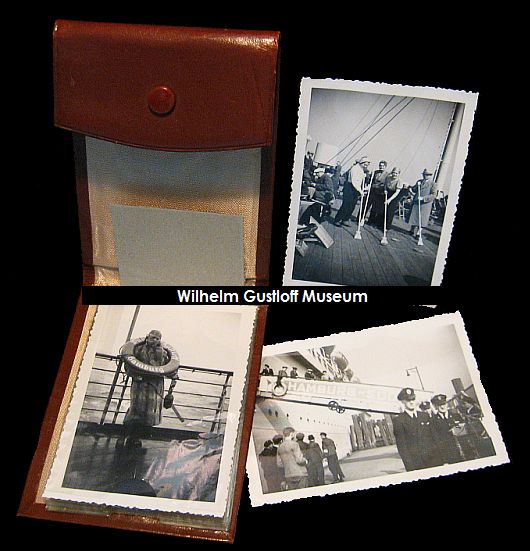
Non-Ship Related:
Wilhelm Gustloff Cuff Title
Likely a SS commerative cuff title, similar to commerative CTs for Horst Wessel. Sounds plausable given Gustloff's relatively early (Swiss) NSDAP membership and subsequent murder. Possibly just a fantasy piece as well.
These have been seen for Adolf Hitler, Horst Wessel, Prinz Eugen, etc.
20" in length - reproduction piece.
Wilhelm Gustloff Cuff Title
Likely a SS commerative cuff title, similar to commerative CTs for Horst Wessel. Sounds plausable given Gustloff's relatively early (Swiss) NSDAP membership and subsequent murder. Possibly just a fantasy piece as well.
These have been seen for Adolf Hitler, Horst Wessel, Prinz Eugen, etc.
20" in length - reproduction piece.
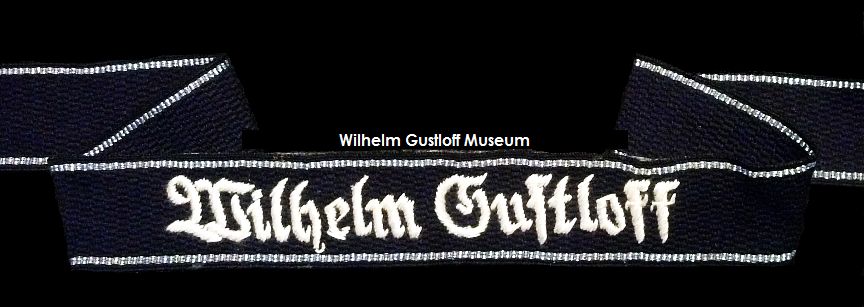


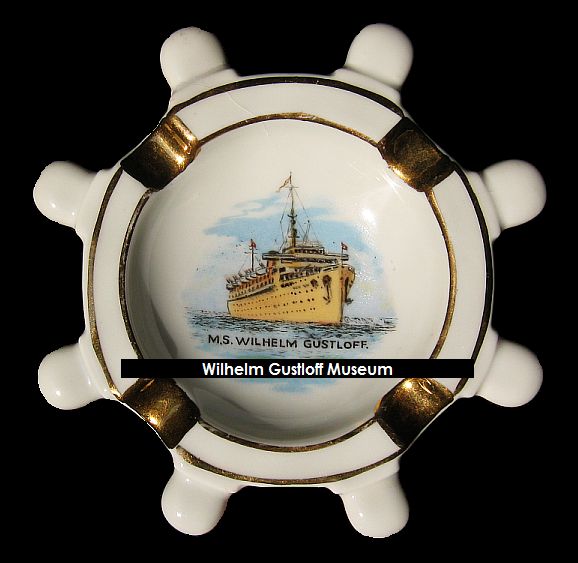
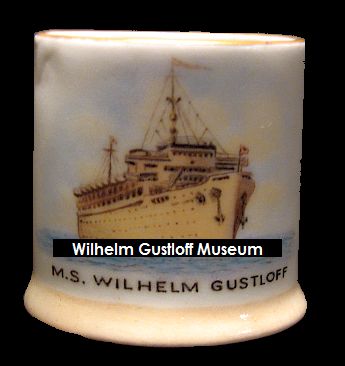
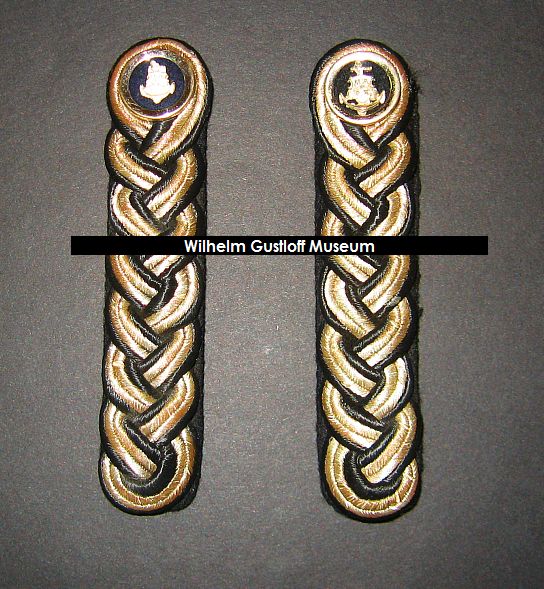
Below Left: Souvenir lighter purchased on board during her 4th voyage to Norway.
Above Left: Souvenir Gustloff model on a marble base with "Hamburg"
Right: Two HAPAG epaulets that were found in a box in Germany with several pieces of memorabilia from the Wilhelm Gustloff. Quoted as being worn by one of the officers on board, whether they actually were worn by someone on board the ship is unknown. HAPAG ran the Robert Ley not the Gustloff, so it's unlikely.
Above Left: Souvenir Gustloff model on a marble base with "Hamburg"
Right: Two HAPAG epaulets that were found in a box in Germany with several pieces of memorabilia from the Wilhelm Gustloff. Quoted as being worn by one of the officers on board, whether they actually were worn by someone on board the ship is unknown. HAPAG ran the Robert Ley not the Gustloff, so it's unlikely.
I had originally thought these were post war reproduction pieces (right) because they were transfer decals, but recent correspondence with KPM Königliche Porzellan-Manufaktur Berlin revealed that transfer decal pieces were mass produced in Germany for the general population. So the piece is original to WWII Germany, it is just not something that was sold on board the ship itself.
KPM produced several types of china with the KPM scepter makers mark. The hand painted pieces were sold aboard in her gift shop, but other pieces were produced white and sent off elsewhere. The transfer decals were then applied by someone else and sold as general souvenirs to the public.
Other companies also did similar pieces during this time. This ashtray was made by the Krister Porcelain Factory, which was founded 1831 in Waldenburg (today Poland). Krister produced cheap porcelain for daily use with print decoration. The trademark (green crown with the letters KPM) had been used between 1925 and 1945.
KPM produced several types of china with the KPM scepter makers mark. The hand painted pieces were sold aboard in her gift shop, but other pieces were produced white and sent off elsewhere. The transfer decals were then applied by someone else and sold as general souvenirs to the public.
Other companies also did similar pieces during this time. This ashtray was made by the Krister Porcelain Factory, which was founded 1831 in Waldenburg (today Poland). Krister produced cheap porcelain for daily use with print decoration. The trademark (green crown with the letters KPM) had been used between 1925 and 1945.
Wilhelm Gustloff Souvenir Sailor Doll
Sailor dolls were created by Norah Wellings, England. Norah, the chief designer for Chad Valley, opened her own doll company Victory Toys with her brother Leo in 1926. Travel by ship was a very popular means of transport during this period and almost all the shipping companies sold the souvenir sailor dolls on board their ocean liners. They were produced right up until 1960, the year of Leo's passing, when the company closed. (Excerpt - A Treasured Past Blogspot.) So far I have only seen three Wellings dolls created for German ships. (Unfortunately, at this point, I do not remember which ones they were).
These Wilhelm Gustloff sailor dolls stand at 11". The mützenband reads "M.S. Wilhelm Gustloff". Mint condition on one, fading away on the other with he top layer of gold writing peeling away. One is complete with a souvenir ship's wheel pin on his chest. Overall they are in very sturdy condition. If they could talk, the stories they could tell!
Sailor dolls were created by Norah Wellings, England. Norah, the chief designer for Chad Valley, opened her own doll company Victory Toys with her brother Leo in 1926. Travel by ship was a very popular means of transport during this period and almost all the shipping companies sold the souvenir sailor dolls on board their ocean liners. They were produced right up until 1960, the year of Leo's passing, when the company closed. (Excerpt - A Treasured Past Blogspot.) So far I have only seen three Wellings dolls created for German ships. (Unfortunately, at this point, I do not remember which ones they were).
These Wilhelm Gustloff sailor dolls stand at 11". The mützenband reads "M.S. Wilhelm Gustloff". Mint condition on one, fading away on the other with he top layer of gold writing peeling away. One is complete with a souvenir ship's wheel pin on his chest. Overall they are in very sturdy condition. If they could talk, the stories they could tell!
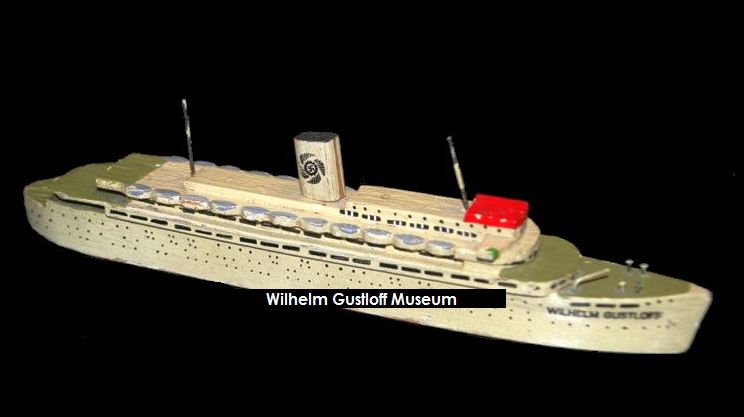
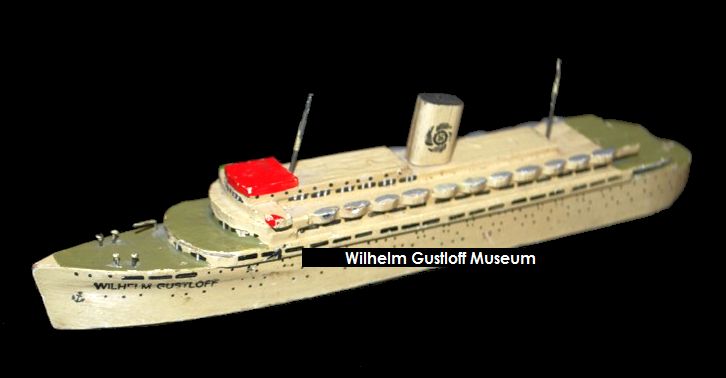
Vintage Wilhelm Gustloff wooden toy boat, c1938.
.

6: Wilhelm Gustloff Gau Düsseldorf Special Variation:
A friend of mine has collected 550 tallies over the past 17 years including the Gau tallies from the Oceana, Der Deutsche, Sierra Cordoba, Monte Olivia, Monte Sarmiento. When asked about this particular tally, he replied, "Why the Gau Düsseldorf had 'special' tallies is pure suspicion, but I strongly tend to say that this was just another way how to raise money from the DAF members of the districts Düsseldorf and Essen. If the Deutsche Arbeitsfront got them made for 1 Reichsmark and they sold the tallies in their shops for 1.50 Reichsmark to anyone who booked a voyage on the individual ship - well this is good business I would say. And for the travelers it was just another souvenir, directly to attribute to the voyage they booked." What makes this tally more special is that I also have a photograph of the Gau mützenband being worn on board the liner at the time. This postcard image is of several passengers on board the Wilhelm Gustloff in the Norwegian Fjords in 1939. I zoomed in to show the passenger wearing this tally on the Sun Deck. There is another passenger in the image wearing the standard Wilhelm Gustloff tally. I also have a second Gau Düsseldorf mützenband that came from the collection Wilhelm Zahn as noted below.
A friend of mine has collected 550 tallies over the past 17 years including the Gau tallies from the Oceana, Der Deutsche, Sierra Cordoba, Monte Olivia, Monte Sarmiento. When asked about this particular tally, he replied, "Why the Gau Düsseldorf had 'special' tallies is pure suspicion, but I strongly tend to say that this was just another way how to raise money from the DAF members of the districts Düsseldorf and Essen. If the Deutsche Arbeitsfront got them made for 1 Reichsmark and they sold the tallies in their shops for 1.50 Reichsmark to anyone who booked a voyage on the individual ship - well this is good business I would say. And for the travelers it was just another souvenir, directly to attribute to the voyage they booked." What makes this tally more special is that I also have a photograph of the Gau mützenband being worn on board the liner at the time. This postcard image is of several passengers on board the Wilhelm Gustloff in the Norwegian Fjords in 1939. I zoomed in to show the passenger wearing this tally on the Sun Deck. There is another passenger in the image wearing the standard Wilhelm Gustloff tally. I also have a second Gau Düsseldorf mützenband that came from the collection Wilhelm Zahn as noted below.


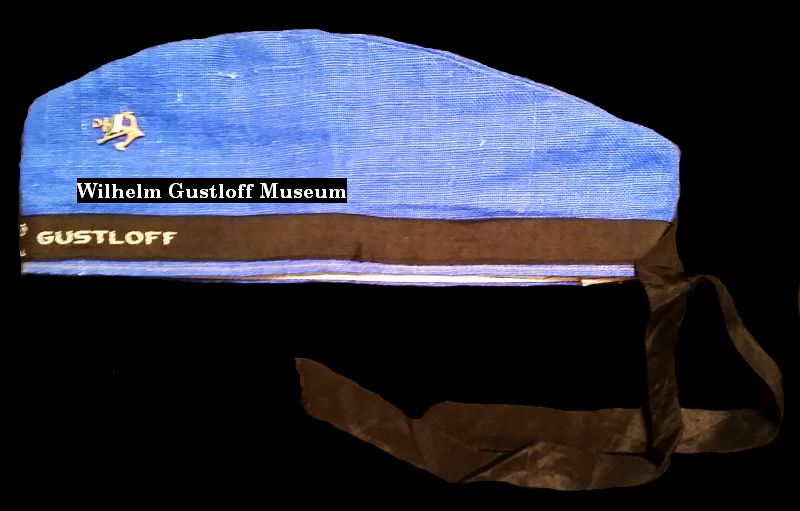
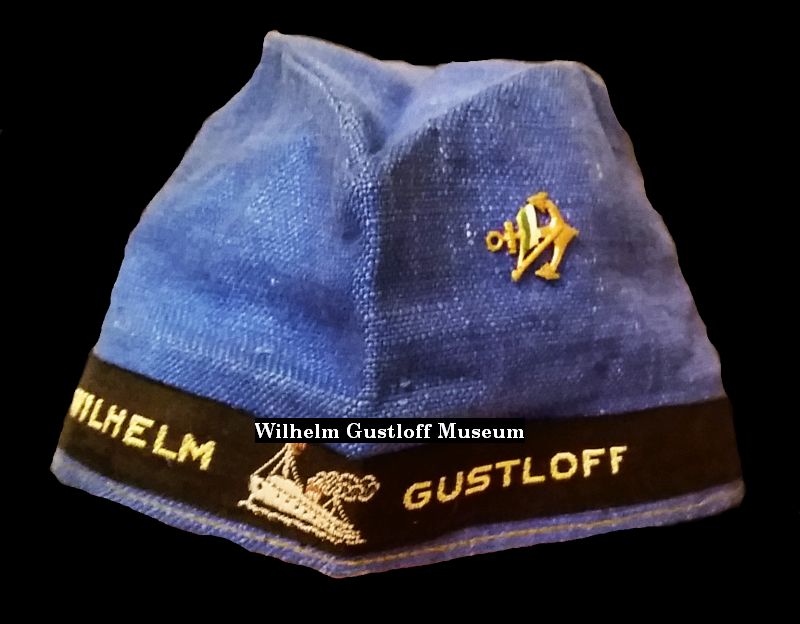
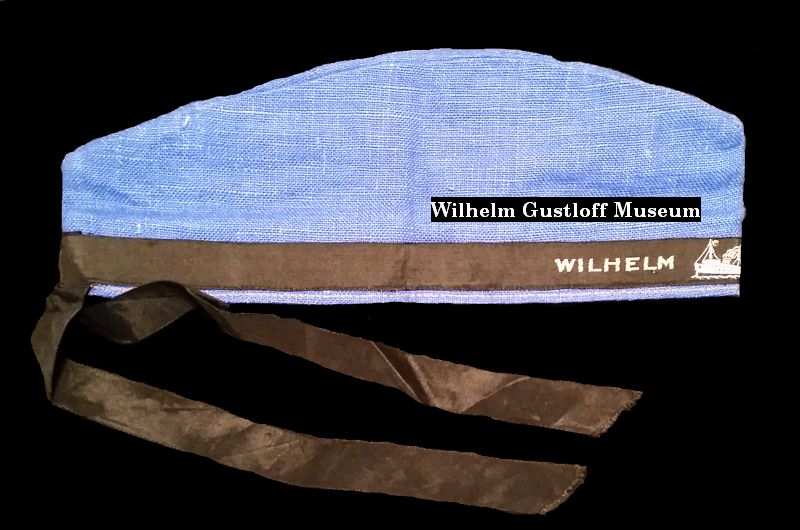
Wilhelm Gustloff Cap & Tally with Anchor Pin
There is nothing like purchasing a piece with a great back story to it! I came across a larger collection of Gustloff souvenirs including souvenir cap tallies, a leather wallet, on board dining tickets, and food vouchers. When I was in the process of purchasing this piece from that collection, I was told that they all came from the estate of Korvettenkapitän Wilhelm Zahn. He was one of the commanding officers during the sinking of the Wilhelm Gustloff and after the war, the previous owner purchased a large amount of his military decorations and Gustloff items from his estate.
There is nothing like purchasing a piece with a great back story to it! I came across a larger collection of Gustloff souvenirs including souvenir cap tallies, a leather wallet, on board dining tickets, and food vouchers. When I was in the process of purchasing this piece from that collection, I was told that they all came from the estate of Korvettenkapitän Wilhelm Zahn. He was one of the commanding officers during the sinking of the Wilhelm Gustloff and after the war, the previous owner purchased a large amount of his military decorations and Gustloff items from his estate.
The tally is attached to the cap, which is made of a denim material and a 1" white leather lining inside the cap at the base. There is also a small anchor / flag pin in the hat. Measures 27cm long, 10cm high, 16cm wide when opened. I believe this was one of those Gustloff pieces produced for the German market that was never on board the ship itself since it does not match the official souvenir mützenbands sold on board the liner. There is another piece of information that I have heard where it could possibly be a children's souvenir hat that was sold aboard. Until more information becomes available, I cannot say which is true.



Left:
Small Wilhelm Gustloff plaque, metal rimmed and painted under celluloid. Two small holes on either side for mounting. Backmarked D.R.G.M. on wood.
Right: A Christmas card sent to the workers at Blohm & Voss in December of 1940 featuring the Wilhelm Gustloff on the front.
Small Wilhelm Gustloff plaque, metal rimmed and painted under celluloid. Two small holes on either side for mounting. Backmarked D.R.G.M. on wood.
Right: A Christmas card sent to the workers at Blohm & Voss in December of 1940 featuring the Wilhelm Gustloff on the front.

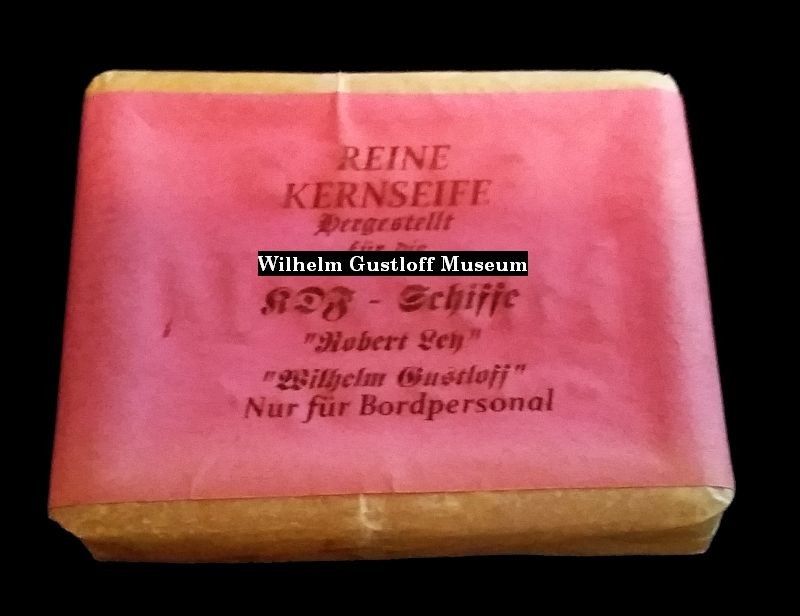
Left: Interesting little post-war bell. Gold-painted.
Inscription: Wilhelm Gustloff - The victims - DDK e.V.
6cm x 8cm.
I am not sure what to categorize this piece as, so I placed it here.
Right:
"Pure Curd Soap made for the KdF Ships Robert Ley, Wilhelm Gustloff. For on board personal." I bought this purely as a curiosity piece, but it is not real. I suspect it is period soap with a post-war label attached as another "knock-off" period item. Soap manufactured by the Flammer Heilbronn Soap Factory, Germany. Over the years I have learned that mostly anything with a paper label or engraving is a post-war reproduction.
Inscription: Wilhelm Gustloff - The victims - DDK e.V.
6cm x 8cm.
I am not sure what to categorize this piece as, so I placed it here.
Right:
"Pure Curd Soap made for the KdF Ships Robert Ley, Wilhelm Gustloff. For on board personal." I bought this purely as a curiosity piece, but it is not real. I suspect it is period soap with a post-war label attached as another "knock-off" period item. Soap manufactured by the Flammer Heilbronn Soap Factory, Germany. Over the years I have learned that mostly anything with a paper label or engraving is a post-war reproduction.

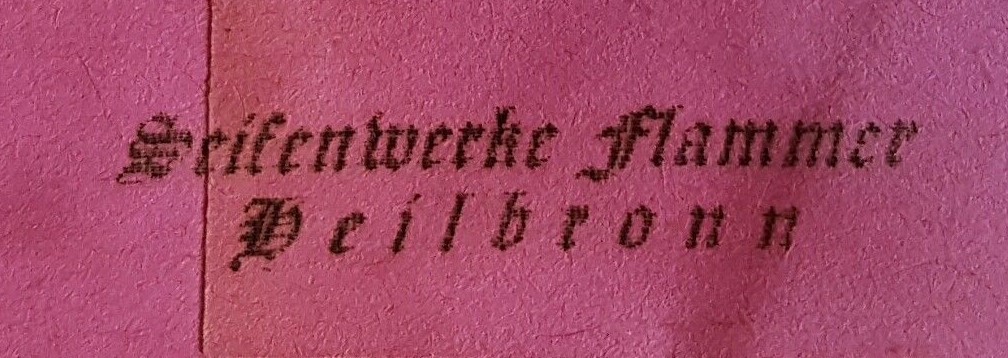
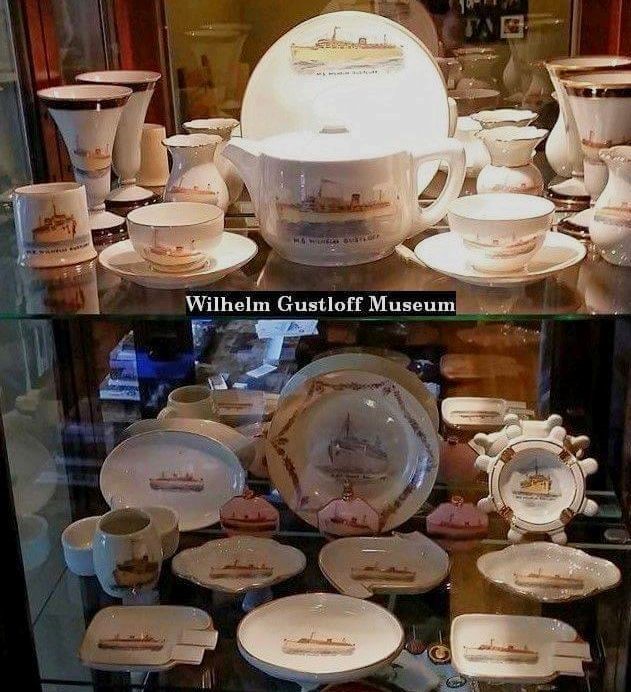
Other items shown below include small souvenir vases from the liner with a miniature teacup & saucer. Two soap dishs measuring 13,5 cm x 9,2cm x 1,8 cm. Most of the gold trim has rubbed off one of them over the years. The second is slightly smaller with the gold rim intact. The last piece is an unusual souvenir piece with 3 separate containers & handle. The image on the front is a first in this style and it looks more like the Robert Ley than the Wilhelm Gustloff. Numbered 3602.
Fake, Fantasy, and Reproduction Wilhelm Gustloff Souvenirs
As with any disaster, once the notoriety of it reaches a point where there is a demand for artifacts pertaining to the event, fake items will eventually find their way into the market. When I first began collecting Wilhelm Gustloff items back in 2007, I assumed everything with the Wilhelm Gustloff name was a legitimate piece of history. As I began to become more familiar with the ship and her artifacts, I soon realized that some of the items that I had purchased were fake fantasy pieces made in Europe within the last 10 or 20 years. At that point, I began to archive photographs of all Gustloff pieces I came across and gathered what information I could. It is believed that many of these pieces are being made by the same person and trying to pass them off as real. Below is just a sampling of fake items from the Wilhelm Gustloff. The fake lifejacket can be viewed under the Pegaway Rescue page.
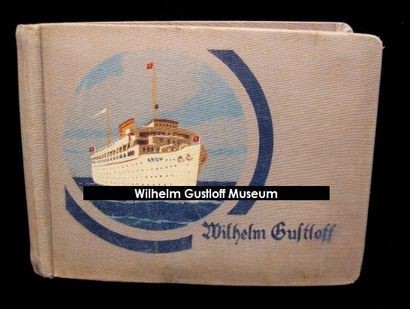
Standard German Market Wilhelm Gustloff China
As noted above, I had originally thought these were post war reproduction pieces because they were transfer decals, but recent correspondence with KPM Königliche Porzellan-Manufaktur Berlin revealed that transfer decal pieces were mass produced in Germany for the general population. Other companies such as Krister Porcelain Factory also did similar pieces during this time. Shown below are additional photos from our archives that showcase some of the additional Wilhelm Gustloff pieces that were sold in Germany during 1938 and 1939, but these were never on the liner itself.
So how have I come to the decision that these artifacts are fakes you may ask? I have had several conversations with other Gustloff collectors and discussed these items at length. I also had conversations with the owners of some of these items insisting they are real and they firmly stood by their decision when I declined to make an offer to purchase. The overall findings are as follows:
#1 - Every one of the items above have one commonality - they are all non-souvenir items with the name of the Wilhelm Gustloff placed upon them. The most common argument I have heard is that the KdF marked their items with the name of the ship so no one would steal them. This cannot be further from the truth. From the dawn of steamships up to the current cruise liners being built, there has never been a ship where this was a common practice. Most of the time, items like china, silverware, glass, etc., was made to be interchangeable among liners. This was likely true with both the Wilhelm Gustloff and Robert Ley. These items would never have her name engraved on them. Furthermore, their patterns do not match the patterns that were known to have been used on board.
#2 - Many of the pieces are random items that are not even of the same time frame or type used on the ship. There is no rhyme or reason to have such a random item like a metal pick with her name engraved on it. The metal postal stamp is not correct for the postal stamps used aboard the Gustloff - the year would have never been produced into the stamper. The ship plaque in images 19 and 20 isn't even an image of the Gustloff. You can see it was later engraved to give it the Gustloff name. The life ring is the wrong color and the real ones on the Gustloff never had this style of lights among several things wrong with the piece. The port hole was also engraved as being part of the Wilhelm Gustloff. Seeing as it is the wrong size, type, and in perfect condition - it is an obvious fake. You can again see where it was engraved after the fact. Many of these are also poorly made items. The KdF clock has the Wilhelm Gustloff name sloppily painted onto the back with a stencil.
#3 - Souvenirs on board the KdF fleet weren't engraved anyway. There is no known legitimate engraved souvenir or artifact known to have come from any of the KdF's 15 passenger liners.
#4 - Have you ever seen these items for other KdF ships? No. Cap tallies, souvenir china pieces, pins, and photo albums are all known to be authentic souvenirs in part because they were available on all other ships of the KdF fleet - Berlin, Dresden, Oceana, St. Louis, Stuttgart, Der Deutsche, Milwaukee, Sierra Cordoba, Monte Sarmiento, Monte Olivia, Monte Cervantes, Monte Pascoal, Monte Rosa, and the Robert Ley. The Wilhelm Gustloff is the only one where items like these have surfaced. I have even seen gas masks labeled from the Gustloff! If they were true pieces, there would be more of the same items around from ships like the Monte Rosa which survived the war.
Some items I chose to break down individually:
Photo #2 and #3: Light fixture engraved with Property of the Wilhelm Gustloff. The owner of this piece contacted me and stated that it came from the
dining room of the Wilhelm Gustloff. He said there was a room for spare parts and that is why it survived. (After reviewing the deck plans,
there is no such room on the ship). He attached a photo of the same light fixture in an image he found on this site. While the owner is a friend of mine
and we made several successful transactions of authentic artifacts in the past, I informed him that it was a fake and unfortunately not interested. He
believed it was a genuine piece and the photo proved it, but I have builders photos of the room and the lights are clearly shown as clear, frosted glass
with vertical cut glossy embellishments meeting in the center bottom of each light. They are not the solid green as shown. Regardless, items as common
as light fixtures would never have the name of a ship engraved onto it.
Photos #4 and #5: See below regarding books and paper labels.
Photos #6, #7, and #8: KdF whistle. This whistle came with a note that stated "Rettungsboot Göttingen", or Lifeboat Göttingen. This was one of the rescue vessels that picked up Gustloff survivors the night of the sinking. After discussing this item with another colleague of mine, we both found they were fake labels placed over a standard whistle and they were clearly distressed to look old. Another whistle of the same type has a label for Volkswagen that wasn't even placed on center. It was clear these were stickers. The KdF logo and S.O.S. labels are poor engravings.
Photos #21, #22, and #23: Engraved goblets. The same gentleman who created these fake goblets has been known to produce others with a variety of engravings, but always using the same cups.
Photo #29: Legion Condor silver tray. This is one item I am still on the fence about its authenticity. I have always leaned towards fake for two reasons. The first is that I have seen other trays with engravings of the Wilhelm Gustloff herself that are known to be fake. Secondly, one tray was tarnished all around except where it was cleaned to be engraved. This was a red flag for me.
Photo #37: This Kriegsmarine towel is an obvious fake due to the fact that the Wilhelm Gustloff's name isn't even spelled correctly.
Photo #38, #39, Right: Another item listed by an acquaintance of mine for 800 Euro or almost $1,000 USD. Listed as a porthole from the Wilhelm Gustloff
salvaged by the Russians in 1955 and sold off to Polish farmers, then his grandfather. Unfortunately, this is another fake item. The immediate red flag is the
stamped marks in photos 38 and 39. No ship will ever have the name stamped into a porthole. Otherwise, every random porthole that appears in an online
auction would have a ship's name to go with it. They don't. Even though this porthole matches the style perfectly, a quick check online shows several of
these available for auction from scrapped ships (Far right). Someone obviously purchased one of these and just stamped the name on it. More evidence
that this is a fake item is based on looking at known recovered portholes from the wreck. All images have the bolts attached to the hull plates and they
were cut out with these plates and bolts attached. This one has no bolts or hull plating. That would only mean the divers would have to cut off the
rusted bolts and remove the hull plating to make it this clean - and there is no evidence on this piece that a torch or cutting tool was used to remove them. Why would anyone remove these bolts if it was recovered from such an infamous wreck? The only time you will have a porthole that is this clean around the bolt holes is when it was removed from a ship during its scrapping.
Photo #45: Stationary from the DDG Hansa Line - or Deutsche Dampfschiffahrts-Gesellschaft Hansa. Typed as a menu with a Gustloff stamp added.
The final part of this section address fake labels for the Wilhelm Gustloff, and in some cases, the Robert Ley. The same people who are creating these fake labels have added her sister ship to the mix. Unfortunately, they did not do a very good job of it.
Photo #55, #56: I came across a militaria auction out of Lockdales Auctioneers in England which featured this porthole in September, 2020. The description was, "WW2 German Cast Iron Port Hole, reputedly destine for the German Armed Troop Carrier the "Wilhelm Gustloff" who was having the heavy brass port holes replaced with iron ones, as brass was in much needed supply. However she was sunk by a Soviet submarine before the refit in January 1945. (very heavy)."
I was asking around online about the practice of switching out portholes, to which nobody (including myself) had heard of this occurring on ships of the time. It would not have been worth the time and effort to do anything like this. I had to email the auction house several times and request more information from the person who consigned this as to why they believed this was meant for the Wilhelm Gustloff. After several days, I finally received a one line reply: "Sorry but the vendor has no further info to accompany the lot". Someone simply made up the Gustloff story just to sell a new old stock porthole. It ended up selling for 140 GBP. In 2021, it appeared in an online antique shop in the UK, where they were asking 650 GBP for it. As of February 2024, it is listed on eBay for 761,65 Euro. It's not worth the 50 GBP starting bid it once had.
Photo #57 - Fake tennis racket. This item came up for auction in 2021 online. While it was for sale, I spent much time going through hundreds of photographs of the ship and video clips of passengers playing games, but the Gustloff never had a tennis court. Table top tennis was the largest game in the gymnasium, and shuffleboard on the Sun Deck. There is no photographic evidence to suggest this is real. Furthermore, common things from the ship were not marked, and this had the same generic font as the Kriegsmarine bag and armband that never would have been used. The word 'practice' is also in English, which is another immediate red flag for a German ship.
Photo #58 - Fake hospital ship armband. During the brief stint as a hospital ship, armbands were never used aboard per photographic evidence of doctors, nurses, and medical staff. Even if they were, they would be embroidered instead of stamped - a clear sign of a fake piece. The lettering is also incorrect for the period, and the date is 4 years after she was no longer a hospital ship.
Photo #62 - The first example of a fake cap tally, and it's not even from the Wilhelm Gustloff. I came across this fake cap tally from the Robert Ley and purchased it at its value to display next to the originals in the collection. Stitched on different material, this tally uses thicker threading, incorrect lettering, incorrect flags, and most obvious - uses M.S. instead of the ships official E.S. designation.
Photos #63-65 - Over the summer of 2022, a seller on eBay decided to post a bunch of small random items from the world's most famous shipwrecks and selling them for a few dollars at a time. Iron nails from the Titanic for $30 among them. It wasn't long before a coin and button "from the Wilhelm Gustloff" appeared and sold with only one bid. These are not from the wreck, nor are any of these items with their fake COAs.
#1 - Every one of the items above have one commonality - they are all non-souvenir items with the name of the Wilhelm Gustloff placed upon them. The most common argument I have heard is that the KdF marked their items with the name of the ship so no one would steal them. This cannot be further from the truth. From the dawn of steamships up to the current cruise liners being built, there has never been a ship where this was a common practice. Most of the time, items like china, silverware, glass, etc., was made to be interchangeable among liners. This was likely true with both the Wilhelm Gustloff and Robert Ley. These items would never have her name engraved on them. Furthermore, their patterns do not match the patterns that were known to have been used on board.
#2 - Many of the pieces are random items that are not even of the same time frame or type used on the ship. There is no rhyme or reason to have such a random item like a metal pick with her name engraved on it. The metal postal stamp is not correct for the postal stamps used aboard the Gustloff - the year would have never been produced into the stamper. The ship plaque in images 19 and 20 isn't even an image of the Gustloff. You can see it was later engraved to give it the Gustloff name. The life ring is the wrong color and the real ones on the Gustloff never had this style of lights among several things wrong with the piece. The port hole was also engraved as being part of the Wilhelm Gustloff. Seeing as it is the wrong size, type, and in perfect condition - it is an obvious fake. You can again see where it was engraved after the fact. Many of these are also poorly made items. The KdF clock has the Wilhelm Gustloff name sloppily painted onto the back with a stencil.
#3 - Souvenirs on board the KdF fleet weren't engraved anyway. There is no known legitimate engraved souvenir or artifact known to have come from any of the KdF's 15 passenger liners.
#4 - Have you ever seen these items for other KdF ships? No. Cap tallies, souvenir china pieces, pins, and photo albums are all known to be authentic souvenirs in part because they were available on all other ships of the KdF fleet - Berlin, Dresden, Oceana, St. Louis, Stuttgart, Der Deutsche, Milwaukee, Sierra Cordoba, Monte Sarmiento, Monte Olivia, Monte Cervantes, Monte Pascoal, Monte Rosa, and the Robert Ley. The Wilhelm Gustloff is the only one where items like these have surfaced. I have even seen gas masks labeled from the Gustloff! If they were true pieces, there would be more of the same items around from ships like the Monte Rosa which survived the war.
Some items I chose to break down individually:
Photo #2 and #3: Light fixture engraved with Property of the Wilhelm Gustloff. The owner of this piece contacted me and stated that it came from the
dining room of the Wilhelm Gustloff. He said there was a room for spare parts and that is why it survived. (After reviewing the deck plans,
there is no such room on the ship). He attached a photo of the same light fixture in an image he found on this site. While the owner is a friend of mine
and we made several successful transactions of authentic artifacts in the past, I informed him that it was a fake and unfortunately not interested. He
believed it was a genuine piece and the photo proved it, but I have builders photos of the room and the lights are clearly shown as clear, frosted glass
with vertical cut glossy embellishments meeting in the center bottom of each light. They are not the solid green as shown. Regardless, items as common
as light fixtures would never have the name of a ship engraved onto it.
Photos #4 and #5: See below regarding books and paper labels.
Photos #6, #7, and #8: KdF whistle. This whistle came with a note that stated "Rettungsboot Göttingen", or Lifeboat Göttingen. This was one of the rescue vessels that picked up Gustloff survivors the night of the sinking. After discussing this item with another colleague of mine, we both found they were fake labels placed over a standard whistle and they were clearly distressed to look old. Another whistle of the same type has a label for Volkswagen that wasn't even placed on center. It was clear these were stickers. The KdF logo and S.O.S. labels are poor engravings.
Photos #21, #22, and #23: Engraved goblets. The same gentleman who created these fake goblets has been known to produce others with a variety of engravings, but always using the same cups.
Photo #29: Legion Condor silver tray. This is one item I am still on the fence about its authenticity. I have always leaned towards fake for two reasons. The first is that I have seen other trays with engravings of the Wilhelm Gustloff herself that are known to be fake. Secondly, one tray was tarnished all around except where it was cleaned to be engraved. This was a red flag for me.
Photo #37: This Kriegsmarine towel is an obvious fake due to the fact that the Wilhelm Gustloff's name isn't even spelled correctly.
Photo #38, #39, Right: Another item listed by an acquaintance of mine for 800 Euro or almost $1,000 USD. Listed as a porthole from the Wilhelm Gustloff
salvaged by the Russians in 1955 and sold off to Polish farmers, then his grandfather. Unfortunately, this is another fake item. The immediate red flag is the
stamped marks in photos 38 and 39. No ship will ever have the name stamped into a porthole. Otherwise, every random porthole that appears in an online
auction would have a ship's name to go with it. They don't. Even though this porthole matches the style perfectly, a quick check online shows several of
these available for auction from scrapped ships (Far right). Someone obviously purchased one of these and just stamped the name on it. More evidence
that this is a fake item is based on looking at known recovered portholes from the wreck. All images have the bolts attached to the hull plates and they
were cut out with these plates and bolts attached. This one has no bolts or hull plating. That would only mean the divers would have to cut off the
rusted bolts and remove the hull plating to make it this clean - and there is no evidence on this piece that a torch or cutting tool was used to remove them. Why would anyone remove these bolts if it was recovered from such an infamous wreck? The only time you will have a porthole that is this clean around the bolt holes is when it was removed from a ship during its scrapping.
Photo #45: Stationary from the DDG Hansa Line - or Deutsche Dampfschiffahrts-Gesellschaft Hansa. Typed as a menu with a Gustloff stamp added.
The final part of this section address fake labels for the Wilhelm Gustloff, and in some cases, the Robert Ley. The same people who are creating these fake labels have added her sister ship to the mix. Unfortunately, they did not do a very good job of it.
Photo #55, #56: I came across a militaria auction out of Lockdales Auctioneers in England which featured this porthole in September, 2020. The description was, "WW2 German Cast Iron Port Hole, reputedly destine for the German Armed Troop Carrier the "Wilhelm Gustloff" who was having the heavy brass port holes replaced with iron ones, as brass was in much needed supply. However she was sunk by a Soviet submarine before the refit in January 1945. (very heavy)."
I was asking around online about the practice of switching out portholes, to which nobody (including myself) had heard of this occurring on ships of the time. It would not have been worth the time and effort to do anything like this. I had to email the auction house several times and request more information from the person who consigned this as to why they believed this was meant for the Wilhelm Gustloff. After several days, I finally received a one line reply: "Sorry but the vendor has no further info to accompany the lot". Someone simply made up the Gustloff story just to sell a new old stock porthole. It ended up selling for 140 GBP. In 2021, it appeared in an online antique shop in the UK, where they were asking 650 GBP for it. As of February 2024, it is listed on eBay for 761,65 Euro. It's not worth the 50 GBP starting bid it once had.
Photo #57 - Fake tennis racket. This item came up for auction in 2021 online. While it was for sale, I spent much time going through hundreds of photographs of the ship and video clips of passengers playing games, but the Gustloff never had a tennis court. Table top tennis was the largest game in the gymnasium, and shuffleboard on the Sun Deck. There is no photographic evidence to suggest this is real. Furthermore, common things from the ship were not marked, and this had the same generic font as the Kriegsmarine bag and armband that never would have been used. The word 'practice' is also in English, which is another immediate red flag for a German ship.
Photo #58 - Fake hospital ship armband. During the brief stint as a hospital ship, armbands were never used aboard per photographic evidence of doctors, nurses, and medical staff. Even if they were, they would be embroidered instead of stamped - a clear sign of a fake piece. The lettering is also incorrect for the period, and the date is 4 years after she was no longer a hospital ship.
Photo #62 - The first example of a fake cap tally, and it's not even from the Wilhelm Gustloff. I came across this fake cap tally from the Robert Ley and purchased it at its value to display next to the originals in the collection. Stitched on different material, this tally uses thicker threading, incorrect lettering, incorrect flags, and most obvious - uses M.S. instead of the ships official E.S. designation.
Photos #63-65 - Over the summer of 2022, a seller on eBay decided to post a bunch of small random items from the world's most famous shipwrecks and selling them for a few dollars at a time. Iron nails from the Titanic for $30 among them. It wasn't long before a coin and button "from the Wilhelm Gustloff" appeared and sold with only one bid. These are not from the wreck, nor are any of these items with their fake COAs.
Until evidence surfaces to contradict any of these items as fakes, they will continue to labeled as such. As part of the new update, I wanted to add this section to the museum site to guide others upon making informed decisions when they come across items such as these. There are some fake items that I have purchased purely out of curiosity or because they were only one or two dollars:
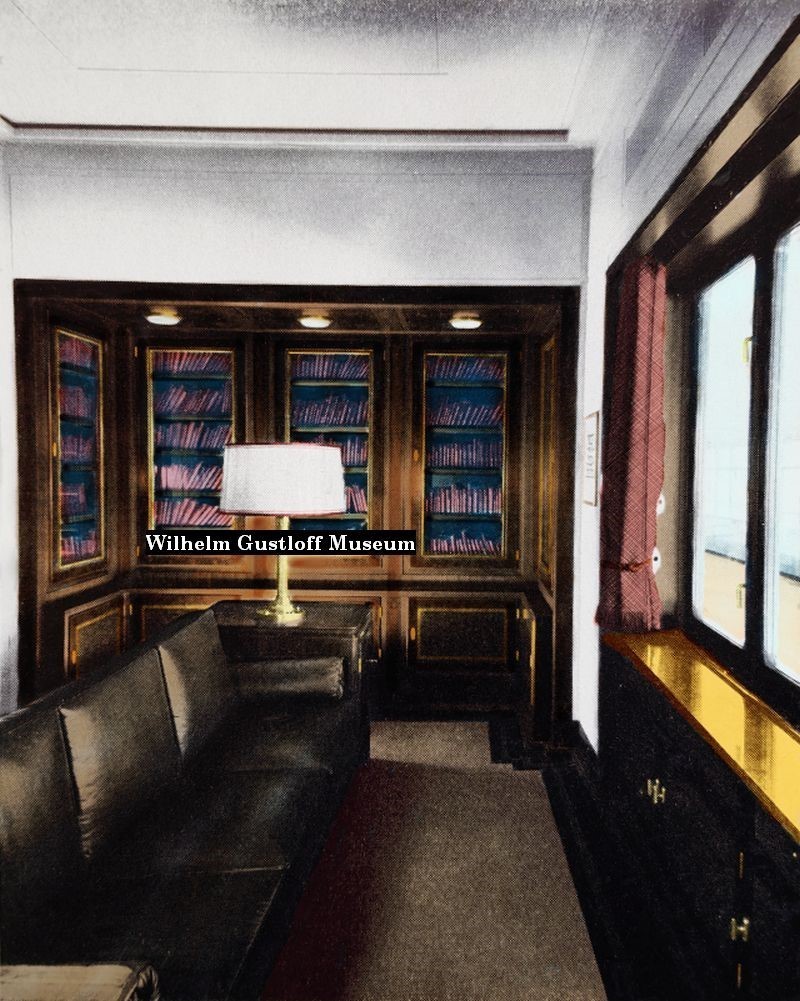
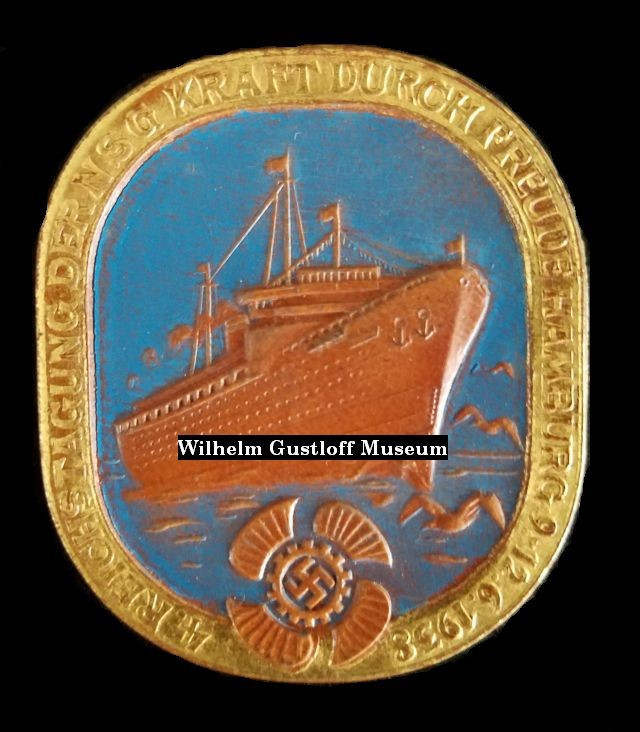
Wilhelm Gustloff Special Voyage Pin
June 9th to 12th, 1938
At a quick glance, this pin appears to be the Robert Ley based on the upper superstructure. In fact, it's the Wilhelm Gustloff with an interesting depiction. She still has her two anchors and the crew promenade isn't placed on the best.
Inscription:
4th Reichstagung of the NSG, Kraft Through Joy, Hamburg, 9-12.6.1938.
From her 4th National Rally of the National-Socialist Fellowship Voyage in 1938. It was originally thought she was berthed in Hamburg for these days during the festivities, but there is a luggage tag with a passengers name on it from England!
June 9th to 12th, 1938
At a quick glance, this pin appears to be the Robert Ley based on the upper superstructure. In fact, it's the Wilhelm Gustloff with an interesting depiction. She still has her two anchors and the crew promenade isn't placed on the best.
Inscription:
4th Reichstagung of the NSG, Kraft Through Joy, Hamburg, 9-12.6.1938.
From her 4th National Rally of the National-Socialist Fellowship Voyage in 1938. It was originally thought she was berthed in Hamburg for these days during the festivities, but there is a luggage tag with a passengers name on it from England!

KDF Passenger Liner Pin
A small plastic pin likely made for the German market for those who donated to a certain Nazi organization. Poorly executed, but clearly meant to depict either the Wilhelm Gustloff or Robert Ley in 1938 or 1939.
A small plastic pin likely made for the German market for those who donated to a certain Nazi organization. Poorly executed, but clearly meant to depict either the Wilhelm Gustloff or Robert Ley in 1938 or 1939.
Fake Book Example
Fake Label Example
Authentic Library Book
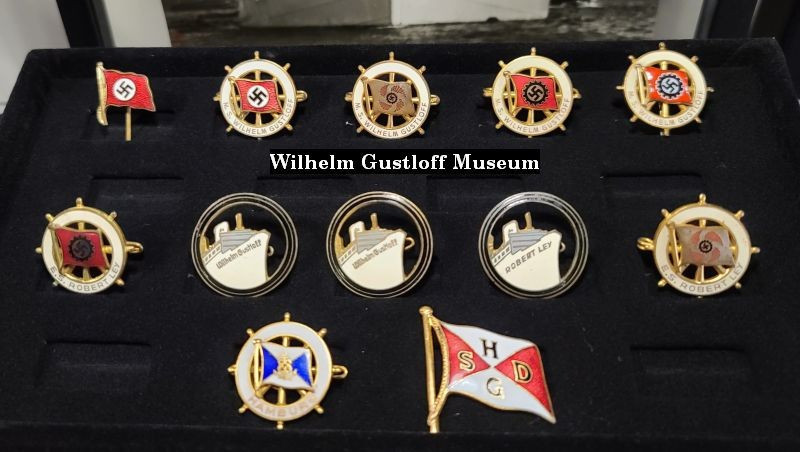
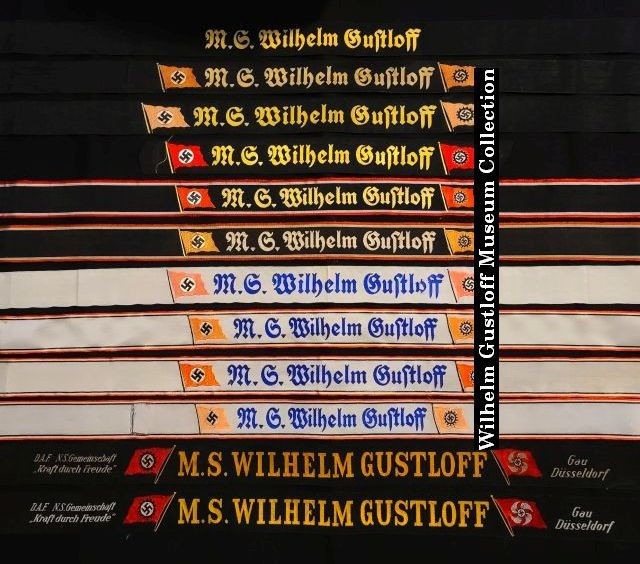
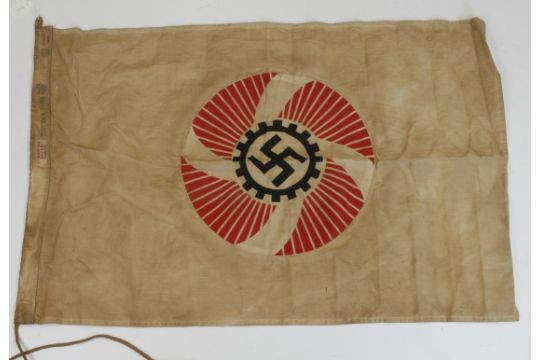

Fake KdF flag from the Robert Ley.
This flag appeared in a Lockdales auction in the UK with only the photo on the right. I decided to bid and won it for $300. However, I later found out there were the stamps on the back (shown below) that give this away as a fake piece. I was able to get a full refund after explaining to the auction house it was a fake, but they promptly relisted it in a new auction starting at 50GBP and not disclosing it was a fake - likely because they didn't want to be stuck with it.
Real flags would've had a paper-material RZ label, and no stamps. The added touch of the E.S. Robert Ley tag makes it "extra fake" if you will. I've also seen 1 or 2 others with the same stamps, but the logo was done worse than this one. The same auction house had a KdF pennant that was red with the white logo - also a fake.
This flag appeared in a Lockdales auction in the UK with only the photo on the right. I decided to bid and won it for $300. However, I later found out there were the stamps on the back (shown below) that give this away as a fake piece. I was able to get a full refund after explaining to the auction house it was a fake, but they promptly relisted it in a new auction starting at 50GBP and not disclosing it was a fake - likely because they didn't want to be stuck with it.
Real flags would've had a paper-material RZ label, and no stamps. The added touch of the E.S. Robert Ley tag makes it "extra fake" if you will. I've also seen 1 or 2 others with the same stamps, but the logo was done worse than this one. The same auction house had a KdF pennant that was red with the white logo - also a fake.
Original & Reproduction Wilhelm Gustloff Cap Tallies
It was only a matter of time before Wilhelm Gustloff and Robert Ley cap tallies began to appear on the market as reproductions - and very good ones at that from the front at least. 2023 saw an explosion of reproduction cap tallies from several liners from HAPAG, HSDG, the KdF, and German naval ships. Forums have begun to light up with members asking if their recent cap tally purchase is original or a reproduction. From the front, it is difficult to tell unless it has the red band across the top and bottom, which is too large compared to the originals. Below is an original black Gustloff tally and a reproduction white tally. (I haven't been able to get my hands on the black version yet). The back is the easiest way to differentiate.
If the back looks like the black tally, with threads seemingly all over, it is an original. Reproductions like the white tally have very neat vertical threads across the back - a giveaway it is a newly made piece.
If the back looks like the black tally, with threads seemingly all over, it is an original. Reproductions like the white tally have very neat vertical threads across the back - a giveaway it is a newly made piece.